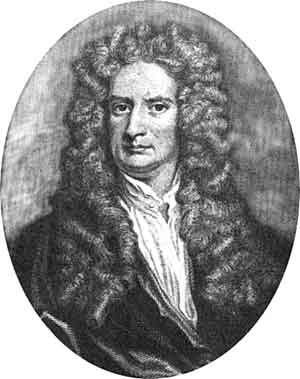
University of California, Irvine
Instructor: Dr. Barbara J. Becker

|
|
The Importance of Quantity in the Eighteenth Century
Eighteenth century mathematicians and natural philosophers owed a great debt to their predecessors in the seventeenth century, in particular to Galileo Galilei (1564-1642). Galileo believed that the book of nature is written in the language of mathematics. His fascination with measurement and number served as the foundation for what some historians have called the "quantifying spirit" of the eighteenth century.
The quantification of natural phenomena was guided by the work of a number of influential thinkers who took up Galileo's mantle in the last quarter of the seventeenth century, in particular Isaac Newton and the German mathematician and philosopher, Gottfried Wilhelm Leibniz.

Gottfried Wilhelm Leibniz (1646-1716) |

Isaac Newton (1642-1727) |
Newton and Leibniz disagreed about what the world is made of and how its parts function. Their views attracted ardent followers during the eighteenth and nineteenth centuries whose arguments shaped our modern concepts of force, energy, and momentum.
Lessons from Simple Collisions
From the time that individuals began trying to describe how objects behave when they collide, there were disagreements over the most useful way to measure what takes place. Many different terms like force, force of motion, quantity of motion, momentum, and quantity of progress were used to describe aspects of bodies in motion before, during, and after an encounter.
Some historians have suggested that these disagreements were merely skirmishes in a war of words, but that doesn't explain why it took so long to resolve the fundamental issues at stake, nor the intensity with which opponents argued their cases. There were profound differences in how individuals like Newton and Leibniz viewed the structure of the world, differences which made it difficult for those who followed them to reach an agreement on the problems associated with contact between moving bodies.
Luckily, it's not necessary to get involved in the nuances of Newton's and Leibniz's philosophies of nature to appreciate the confusion that often arises when trying to describe, in a meaningful way, what happens when moving bodies collide. If you catch a ball in your hand, for example, you feel something. What words will you use to describe what you feel at that instant? What is it about a moving body that gives it its ability to produce an effect on objects it encounters? Where does this ability come from? What is the best way to measure this ability to produce such an effect?
Our every day language presents a lot of pedagogical problems. We talk about "feeling energetic," about campaigns "gaining momentum," about working "under pressure," about being "forced" to do an unpleasant chore. Years of exposure to these terms establishes deeply internalized meanings that can interfere with the average person's understanding of what these terms represent to modern physicists.
Many textbooks (and teachers) at the introductory level feel that they eliminate students' confusion by simply defining the terms with modern mathematical formulas. Force becomes mass x acceleration, for example, while momentum is mass x velocity. What these terms may mean physically, they argue, will be acquired by solving lots of problems. But the fact is that clever students can memorize the formulas, solve the problems, and please their teachers all without having a clue as to what they've done, or what it all means.
What do these terms really represent in a physical sense and why have modern scientists found it convenient to describe collisions as they do?
Newton and momentum
The sensation that is felt when a ball is caught, or the change in motion that is exhibited when one ball collides with another in a game of croquet was described by Newton and Leibniz in very different ways. Both men agreed that "force" has an important role to play in such situations, but they disagreed on what "force" is and how it can best be represented mathematically.
For Isaac Newton, it made no more sense to say that the amount of motion a ball has is a kind of force that gives it the ability to move, than it did to say that a spring's springiness is caused by its springy nature, or that a magnet's magnetism is caused by its magnetic properties. Instead of talking in circles like that, Newton thought it was much better to describe a force in terms of its observable effects.
What your hand feels when you catch a ball is an effect caused by the fact that your hand has brought the ball to a stop. No matter how fast the ball may have been traveling, the sensation you feel will depend on the rate at which the ball comes to rest in your hand. A sudden stop (as in a bare-handed catch) can hurt and even injure your hand. A gradual slowing (as when a ball is caught in a baseball mitt) feels more comfortable.
According to Isaac Newton, these easily observed effects demonstrate that the ball's quantity of motion cannot represent the force of the interaction. The only useful way to describe this force is in terms of the ball's rate of change in its quantity of motion.
Newton agreed with many of his predecessors that a body's quantity of motion could be defined as the product of its mass and its velocity.
He distinguished mass (the amount of stuff inside a body) from weight (a measure of Earth's gravitational pull on a body's mass). And he recognized that while speed is a measure of how fast a body moves, when talking about a body's quantity of motion, it is crucial to take into account the direction of motion as well. Velocity is a term that has come to represent both the magnitude and direction of motion.
Newton's quantity of motion is equivalent to what modern physicists refer to as momentum.
Leibniz and vis viva
In contrast with Newton, Leibniz, believed that what humans suppose they perceive as the stuff of the universe is, in fact, composed of aggregates of simple, dimensionless, indestructible, and immutable points which he called "monads." The essence of all matter is not material at all, but rather a striving to change, or innate force.
Like Newton, Leibniz defined "quantity of force" in terms of the effect, or the potential for effect, a moving body possesses. But he did not agree that the product of mass and velocity was the way to quantify this force.
NOTE: Leibniz used the terms "mass" and "weight" interchangeably when describing the bulk of a body. To avoid unnecessary confusion, however, we shall always use the term "mass."Leibniz agreed that mass x velocity had its use in describing physical interactions. In fact he agreed that this quantity is always conserved in collisions. He preferred to call it a body's quantity of progress. In Leibniz's view, relying on quantity of progress as a measure of force introduces needless complications.
For one thing, including velocity in calculating such a quantity means having to be concerned about direction. Two bodies with the same mass moving with the same speed but in opposite directions would possess equal but opposite quantities of progress. But, Leibniz argued, their striving for change, or quantity of force would be the same.
Also, Leibniz pointed out that if a body's quantity of progress is used as a measure of force, the amount of time involved in a collision would have to be taken into account. Imagine how difficult it would be to measure the amount of time it takes for a baseball to come to a stop in a catcher's glove!
According to Leibniz, such a measurement is totally unnecessary, because time has nothing to do with the measure of force. It is possible to talk about a system's quantity of force in the present without knowing its past because the total quantity of force in a system at any given moment is always the same. Even when it is not manifest on a scale large enough to keep a body in observable motion, it is either moving the smaller components of the body on an imperceptible scale, or storing the force for later action. Leibniz called this force vis viva, or living force. He quantified it as the product of a body's mass and the square of its velocity.
Mathematically, squaring the velocity removed concern about direction of motion and made Leibniz's quantity of force dependent on distance traveled, not time. Leibniz's quantity of force is akin to what modern physicists call kinetic energy.
The vis viva Controversy
Émilie du Châtelet embraced Leibniz's views on force. While she believed that Newton had made a great contribution to human understanding of the how of matter in motion, she objected to Newton's apparent lack of concern for why things behaved as they did. Leibniz's ideas filled that void for her and she developed her own view of nature based on the equal status of force and matter.
Voltaire, on the other hand, held Leibniz's views in contempt, believing, like Newton, that matter is composed of permanent, indivisible, material atoms with force only a transitory ephemeral property of matter. Giving inert matter some kind of internal active principle, in Voltaire's view, was like going back to a mystical representation of nature.
These conflicting views on the problem of impact provided ample fuel for a rather vigorous and long-lived scientific controversy which became known as the vis viva controversy. This controversy arose from fundamental differences in describing the way bodies interact during simple collisions. Resolving this controversy was of the utmost importance since things bumping into each other served as the basic model for all physical behavior.
What exactly is conserved during an impact? What physical changes are important to note? What observable properties can provide the investigator with sufficient information to quantify what actually takes place during a collision? And, more importantly, what is meant by terms "force," "energy," "momentum"? Eighteenth century experimenters wanted answers to these important questions.
Those, like Voltaire, who agreed with Newton that matter is a passive recipient of blows from external sources measured the strength of these blows by calculating the difference in a body's quantity of motion over time:
Force applied over a quantity of time = change in quantity of motion.
![]()
Those, like Émilie, who agreed with Leibniz, that matter possesses an innate active force which is always conserved, quantified collisions in the following way:
Force applied over a given distance = change in quantity of vis viva.
![]()
What was Châtelet's role in the vis viva controversy?
As a translator and synthesizer, Émilie helped to bring the problem of quantity of motion and force to the active attention of a wide variety of philosophers. She invited a number of these individuals to her chateau at Cirey and engaged them in lively discussion on the issue. Participants were thus forced to reflect on their ideas, refine their basic assumptions, and sharpen their use of terms which had been used ambiguously by previous investigators.
Émilie's view that quantity of force and matter are equal players in physical interactions contributed to the development of a new view of nature in which matter not only took up space, but could also serve as the cause of attraction and repulsion observed in such physical processes as chemical reactions, magnetism, and electricity. These phenomena had proven difficult for investigators to understand with only the simple collision to serve as an explanatory model. As more and more curious individuals turned their attention to investigating the properties and behavior of electricity, heat, and light, concern about how to measure the so-called "force of motion" gradually subsided.
|